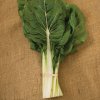You are using an out of date browser. It may not display this or other websites correctly.
You should upgrade or use an alternative browser.
You should upgrade or use an alternative browser.
Can he eat this
- Thread starter Squirts
- Start date
- Joined
- Nov 7, 2012
- Messages
- 5,173
- Location (City and/or State)
- South of Southern California, but not Mexico
That look like green chard, most food references will say it's bad for the oxalate content. I don't agree with that assessment. But iI would limit the amount used to no more than 5% of the total greens fed at any one meal and not use it for more than two meals a week, and I would focus on just using the green part of the leaf.
Adults are a better candidates for eating this than babies. Adults could get the whole leaf, green and white parts, but still in the limited amounts.
https://ndb.nal.usda.gov/ndb/foods/show/11147?fgcd=&manu=&format=&count=&max=25&offset=&sort=default&order=asc&qlookup=chard,+raw&ds=&qt=&qp=&qa=&qn=&q=&ing=
On this chart you can see that the calcium is present at 24 mg/100 grams and the phosphorus is 22 mg/100 grams. This is often expressed in a ration C: P of 24:22, that is marginally okay. Most greens offered should have a much higher amount of C to P. Often the recommend amount would be 2:1 or even as high as 30:1 depending on what resource (thing to read) you find.
The reason why I say it's okay, even with a mediocre C: P ratio is at a low amount in the diet you are offering your tortoise variety, and variety offers some enrichment. Enrichment is good too.
Adults are a better candidates for eating this than babies. Adults could get the whole leaf, green and white parts, but still in the limited amounts.
https://ndb.nal.usda.gov/ndb/foods/show/11147?fgcd=&manu=&format=&count=&max=25&offset=&sort=default&order=asc&qlookup=chard,+raw&ds=&qt=&qp=&qa=&qn=&q=&ing=
On this chart you can see that the calcium is present at 24 mg/100 grams and the phosphorus is 22 mg/100 grams. This is often expressed in a ration C: P of 24:22, that is marginally okay. Most greens offered should have a much higher amount of C to P. Often the recommend amount would be 2:1 or even as high as 30:1 depending on what resource (thing to read) you find.
The reason why I say it's okay, even with a mediocre C: P ratio is at a low amount in the diet you are offering your tortoise variety, and variety offers some enrichment. Enrichment is good too.
Squirts
Member
Okay thank u so much for that info.That look like green chard, most food references will say it's bad for the oxalate content. I don't agree with that assessment. But iI would limit the amount used to no more than 5% of the total greens fed at any one meal and not use it for more than two meals a week, and I would focus on just using the green part of the leaf.
Adults are a better candidates for eating this than babies. Adults could get the whole leaf, green and white parts, but still in the limited amounts.
https://ndb.nal.usda.gov/ndb/foods/show/11147?fgcd=&manu=&format=&count=&max=25&offset=&sort=default&order=asc&qlookup=chard,+raw&ds=&qt=&qp=&qa=&qn=&q=&ing=
On this chart you can see that the calcium is present at 24 mg/100 grams and the phosphorus is 22 mg/100 grams. This is often expressed in a ration C: P of 24:22, that is marginally okay. Most greens offered should have a much higher amount of C to P. Often the recommend amount would be 2:1 or even as high as 30:1 depending on what resource (thing to read) you find.
The reason why I say it's okay, even with a mediocre C: P ratio is at a low amount in the diet you are offering your tortoise variety, and variety offers some enrichment. Enrichment is good too.
I'm pretty sure that's bok choy. I feed it occasionally to my tortoises. They readily eat the green part, but not so much the white part. It is high in vitamin A
Looks like bok choy
It looks like Swiss chard to me.
Trust me, it's bok choy.
Squirts
Member
Yeah it looks like the last one bok ahoy. Thanks everyone
Similar threads
- Replies
- 5
- Views
- 891
- Locked
- Replies
- 9
- Views
- 1K


